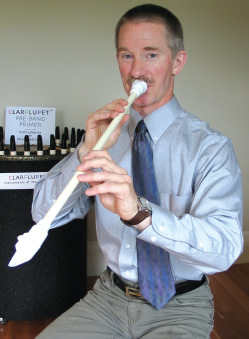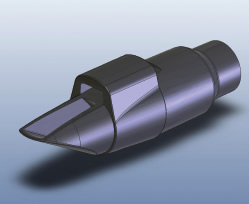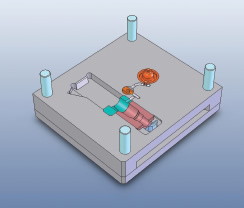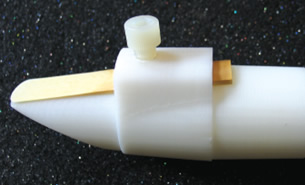A New Twist in Music Education
SolidWorks helps to engineer a musical training tool by combining three instruments into one.
November 2, 2007
By Margaret S. Gurney
 David Heintz, the inventor of the Clarflupet wind embouchure trainer,demonstrates the device by playing the brass mouthpiece section. |
David Heintz, a public school music teacher in Haverhill, NH, set out to change all that by developing a training instrument that evens out the playing field, easing the process for younger students to decide which musical instrument to play, buy, or rent.
Combining his inventiveness with some design engineering and rapid prototyping, Heintz developed the Clarflupet wind embouchure trainer, which, as the name suggests, is a hybrid instrument combining clarinet, flute, and brass mouthpieces into one device that is easier to play than the actual instruments and is more affordable.
One Challenge
Starting with the clarinet, Heintz explains that the “ligature,” typically a metal band with two thumbscrews used to hold a reed onto the mouthpiece, can be difficult for younger players to manipulate. So he knew a new ligature was the key.
 This is an illustration of the single-reed (clarinet) mouthpiece concept created in SolidWorks with surfacing added to the digital model. |  This mold model half, also created in SolidWorks,was designed byengineers at Johnson Precision, Inc. of Amherst, NH. |
Heintz started by pouring industrial resin around a clarinet mouthpiece and fashioned a ligature as a single, integral unit with the mouthpiece. With a rough prototype in hand, it was time to find an injection-molding company — preferably nearby — that could make one. Heintz needed a working prototype so he could refine the design and test it.
“I knew replicating the brass mouthpiece would be relatively easy,” said Heintz, “as would the flute tone hole, but from my prototyping efforts I suspected that injection molding the clarinet mouthpiece would be more difficult. From a cost perspective, however, injection molding seemed to be the way to go.”
 The final rapid prototype of the Clarflupet Single Reed mouthpiece is shown with reed and simplifiedligature, which makes it easier for aspiring clarinetists to attach the reed. |
The RP Stage
Heintz took his model to Johnson Precision, Inc. (JPI) of Amherst, NH. There, as Heintz’s invention began to take shape, testing it would prove a challenge. “Like the medical products we develop, form and functionality had to be right,” said JPI Manufacturing Coordinator Spike Jones. “The mechanical fit between the Clarflupet wind embouchure trainer ]embouchure is a French word that refers to the way one holds one’s mouth and lips to produce a sound on a wind instrument] and the single reed mouthpiece had to be right. The feel and playability had to be right. That’s something that simply cannot be achieved on a computer screen.”
At the time, JPI did not have rapid prototyping capability. So, Heintz contacted a friend who had access to RP equipment, and used Jones’ e-mailed design drafts created using SolidWorks to create a working model out of silicon. The rapid prototype model was then sent back to Heintz for testing.
“That first prototype looked great,” Heintz says, “but it was a disaster in performance.” Sent back to the drawing board and armed with files, sandpaper, and modeling clay, Heintz remodeled a new prototype.
Once this model became playable, it was sent back to Jones at JPI for a new draft to be made. Jones suggested that the new design would best be manufactured using a new approach to the steel mold design. While the mold would be more complicated, it would allow for the new design elements.
With a brass mouthpiece and clarinet mouthpiece on either end of a flutelike body, and a single flute air hole near one end, the instrument allows for a single tone from each playing position. Any mouthpiece will play a pitch by itself.
As all the brass mouthpieces function the same way, the flute and trumpet mouthpieces are not different from real ones, but the flute tone-hole does not have a lip plate. With no fingerings needed, students can focus attention on creating the wind embouchure. Plus, they are using a mouthpiece that is identical in size and shape to the real thing.
The final mouthpiece is manufactured from black polycarbonate, and the pipe center is made from PVC.
Meanwhile, JPI contacted another Amherst company, PolyJect, Inc. for its rapid prototyping capabilities. “Having this local contact gave us a time and efficiency advantage,” said Heintz. “We could e-mail new adjustments in the design and have a model to test in two or three days.”
The Final Draw
“Several redrafts and ABS plastic rapid prototypes later,” Heintz says, “we had a model that played wonderfully. It was easy to blow and much more forgiving for young, inexperienced students just learning. Every wind instrument requires a particular embouchure. This new design responded and produced sound when the students were just close to the correct position, thus providing an early sense of success and confidence.”
“Once I was assured that the design was indeed functional,” Heintz adds, “it was time for Spike Jones to design the computer drawings of the steel mold.”
Jones explains, “Having a physical representation of the 3D CAD model for David Heintz to touch and play prior to cutting mold steel was a critical factor that allowed us to move the project from concept to production quickly and efficiently and with confidence.”
Music for All
Asked if the instruments were under production yet, Heintz says, “I received the first run samples in the mail yesterday ]October 3, 2007] and tested four sets of mouthpieces. They are going to work beautifully.”
Ultimately, the customized Clarflupet Pre-Band Primer will include packages of 25 Clarflupet wind embouchure trainers (patent pending) made in polycarbonate and PVC, plus reeds, drumsticks, practice pads, cleaning system, instructional materials, and a round cart for storage and transportation between classrooms. The Clarflupet wind embouchure trainers will also be sold individually.
By making a music education experience available to all ages, abilities, and at a manageable price, Heintz masterminded a new approach to teaching music, made all the more possible by rapid prototyping. A patent is now pending on the Clarflupet wind embouchure trainer — and new ideas are on the drawing table.
More Information
Clarflupet
Pike, NH
clarflupet.com
Johnson Precision, Inc
Amherst, NH
jpi-plastics.com
PolyJect, Inc.
Amherst, NH
polyject.com
SolidWorks
Concord, MA
solidworks.com
Margaret S. Gurney is the editor for new products at Desktop Engineering magazine. To remark on this article, send your comments via e-mail to newproductsmailto:[email protected].
Subscribe to our FREE magazine, FREE email newsletters or both!
About the Author
DE’s editors contribute news and new product announcements to Digital Engineering.
Press releases may be sent to them via [email protected].






